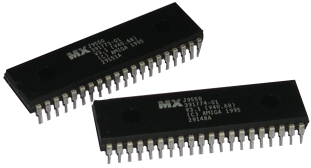The WHDLoad AutoBooter is designed to allow games/demos installed via the WHDLoad system (www.whdload.de) to be loaded by Amiberry in a single-file format (e.g. a ZIP or .LHA archive). The file should be specified from command line with the option -autowhdload=<file>
What do you need to install WHDLOAD and IGame? The ROM.key is needed for the Kickstart ROMS from Amiga Forever to work. Optional packages: Kickstart 3.1 (version 40), it fixes some problems in earlier releases, it also provides some new features which are used by WHDLoad when available like MemoryPools giving better performance if many files are used by the installed program.
Note: Although Amiberry permits the parsing of .ZIP files into the command line, RetroPie does not currently handle WHDLoad files in this format, and we advise the use of .LHA format files only. Currently available resources for WHDLoad games are provided as LHA, and .ZIP is included for legacy compatibility only.

Emulator Requirements
The following archive should exist adjacent to the Amiberry binary file:(These folders/files are provided with Amiberry)
whdboot/boot-data.zipmust contain the Amiga WHDLoad Booter program.
However, an unpacked whdboot/boot-data folder may also be used.
The following directories must exist:
whdboot/game-datamust contain game specific data which can improve the compatibility of an individual game.whdboot/save-datawill contain game specific written information. this should contain the following sub-folders, which can be empty by default;- Autoboots (Will be written to by the Booter)
- Debugs (Will be written to by the Booter)
- Savegames (Will be written to by WHDLoad)
- Kickstarts (Symlinks will be created here - see below)
How it Works:
The booter will automatically mount the HD booter and the game data to the emulated system for easy loading. It will also attempt to select appropriate settings for the game, based on the information available.
The WHDLoad booter uses an A1200 Kickstart 3.1 rom and will search for availability of this rom in the kickstarts path already selected on previous ROM scanning. This is essential for the booter to work.
Where a game requires a slower CPU (e.g. 68000) the A600HD Kickstart 2.05 rom will be searched for and used if available, otherwise the system will revert to a 68020 ECS setup.
A note on WHDLoad Kickstart files (Maximising Booter Compatibility)
Some WHDLoad games require Kickstart files to be made available in Devs:Kickstarts. These files should either be manually copied save-data/Kickstarts, or otherwise Amiberry will attempt to make 'symlinks'to these files if they are already available in the Kickstart paths location.
For maximum compatibility it is recommended to have the following files, located in the position pointed to by the 'kickstart path' value, which can be set via the Paths panel.
Should you wish to create actual copies of these in Devs/Kickstarts, the renamed name is also stated below.
- Kickstart v1.2 rev 33.180 (1986)(Commodore)(A500-A1000-A2000).rom - named: kick33180.A500
- Kickstart v1.3 rev 34.5 (1987)(Commodore)(A500-A1000-A2000-CDTV) - named: kick34005.A500
- Kickstart v3.1 rev 40.68 (1993)(Commodore)(A1200).rom - named: kick40068.A1200
The full list of compatibile / symlinked Kickstart files is detailed in the Kickstart ROMS (BIOS) section of this Wiki.
Amiga Kickstart Roms Download
Game Specific Settings (Improving Game Compatibility)
The preferences from an individual game can be loaded in one of two ways;
- From the
whdload_db.xmlfile - From a file named equivalent to the selected file, with the extension changed to
.whde.g.Infection_v1.0.whdwould accompany booting of the fileInfection_v1.0.lha
The .whd file should be placed in the same location as the whdload_db.xml file.
If available, the .whd file will act as the source for hardware settings, and will take priority over the XML settings. However, this is not stored in the standard .uae file format and is instead specified using the following format;

Note: the above values are all commented out using the ; character in from of each line!
This layout is also used in the <hardware> tag within the XML file. The XML file can also contain an identifier for games packages using it's SHA1 value and custom control options within the <custom_controls> tag. The latter follows the Amiberry .uae options format. E.g. joyport2_amiberry_custom_none_south=Right Shift
When loading a game, if an equivalent .uae config file for the game is found in the Configurations Path, this (and only this) will be used for the game's individual preferences. This allows the user to create bespoke configurations for individual games, which will not be erased when updating the XML/Database files.
Host Specific Settings (The User's Specific Requirments)
In the file whdboot/hostprefs.conf you can specify a number of options to be used as the defaults when running a game in this way. These relate to general Amiberry settings. These are generally used to decide what controller or non-game specific settings you would like applied to the game on loading. Examples are given (although commented out) in the provided file.
Recent Posts
- Chupulu Kalisina Subhavela Serial Watch Online Today Episode
- Varsham Mp3 Songs Free Download Atozmp3
- One Piece Perang Marineford Full
- Buku Sosiologi Politik Pdf
- Deadmau5 Get Scraped Zip Mediafire Gta San Andreas Download
- Edius Project File Ezp Free Download
- Babok Guide Pdf EspaГ±ol
- Ff Qtype Pro Square Book Font Free Download
- The Pillows Discography Torrent
- Wow Item Dupe Hack 3.3.5
- Karte Ho Tum Kanhaiya Song Mp3 Download
- Aditya Hridaya Stotra In Hindi Pdf
- Football Manager 2005 English.ltf
- Xenoblade Chronicles Wii Iso Pal Torrent
- Obrazac Za Rastavu Braka Pdf Files
- Xforce Adobe Cs6 Keygen Invalid Request Code
- Itools Serial Number
- Exchange Server 2013 Iso Torrent
- Fifa 07 Classic Teams Patch
- Libro De Biofisica Medica Pdf Download